

6 Things to Remember to Prevent Your Training from Failing - Learning Rebels. We’ve all been around the block a time or two and have participated and/or created our fair share of corporate training events.

Some information sticks and others are forgotten about. Some events are cursed as a waste of time before participants even get out the door, knowing the time will never be recovered and it sucks. There is a common misconception in the training world that people within organizations don’t want to learn new stuff. As training practitioners, we say participants are distracted, unfocused, and disengaged. We claim it’s their fault participants forget the lessons presented because they weren’t in the moment and not engaged. Well, we’re wrong. People want to learn, we just don’t accept that people want to learn the way they want to learn. Before we even start, I assume you have determined there is a real problem to solve…right? 1. We spend all this cash to bring people together or to create a virtual training environment, then what do we do?
2. 3. 4. 5. 6. Like this: 7 things to check before you design training -Quick needs analysis. If you've gotten here, I'm the right person for the job, I'm motivated, I have support from my managers, I know how high I'm supposed to jump, and I have all the information I need to wrangle those widgets.
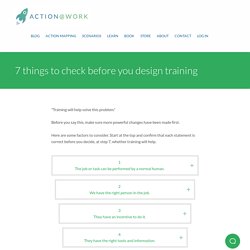
But I'm still struggling to wrangle well. It looks like practice will help. So maybe training will improve my performance. In this case, "training" means "practice activities, appropriately scaffolded" and not "information dump with quiz. " Remember, I have a lot of information already -- how to set up the wrangler, how to interpret the error codes...
But do I really need training? If you're convinced practice activities will help me, don't get trapped in the "event" mindset and create a course or one-time workshop. If the task requires judgment calls or is emotionally challenging, consider organizing discussion groups and other peer support. A one-time course is rarely the solution.
How design thinking can save workplace learning. The core problem I see with workplace learning is that we are not developing new approaches.
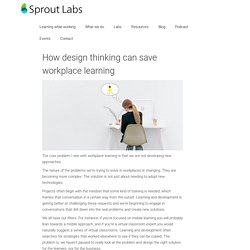
The nature of the problems we're trying to solve in workplaces is changing. They are becoming more complex. The solution is not just about needing to adopt new technologies. Projects often begin with the mindset that some kind of training is needed, which frames that conversation in a certain way from the outset. Learning and development is getting better at challenging these requests and we're beginning to engage in conversations that drill down into the real problems and create new solutions. We all have our filters. What we really need are holistic, creative, practical approaches that are learner and business focused. There’s been a lot of talk lately about the disruption of industries by new startups. Design thinking is about applying the same principles that designers use to business processes and practices.
5 Steps to Using Design Thinking in Learning Experience Design. Traditional instructional design models are based on systems thinking, a paradigm that promotes an analytical mindset.

But our work also requires innovation and creativity. Enter design thinking, a human-centered, collaborative, and iterative approach for deeply understanding an audience and their challenges in order to generate effective solutions. Design Thinking. Design thinking is an approach to problem-solving and creativity based on the field of design.
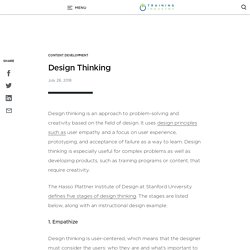
It uses design principles such as user empathy and a focus on user experience, prototyping, and acceptance of failure as a way to learn. Design thinking is especially useful for complex problems as well as developing products, such as training programs or content, that require creativity. The Hasso Plattner Institute of Design at Stanford University defines five stages of design thinking. The stages are listed below, along with an instructional design example. Design Thinking: The Future Of HR Learning And Development. In a fast-changing world, incorporating design thinking into the design of employee training can help to solve problems like maximizing learning, improving engagement, reducing drop-offs and managing attrition.
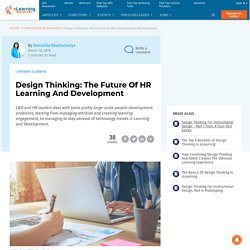
In most organizations, employee training design has more of a top-down approach, where employers decide what learners should learn and how they should learn it, rather than catering to what and how they want to learn. This process has been seeing diminishing returns as a rising proportion of Millennials and Gen Z has joined the workforce. While some organizations have tried to solve this by building access to MOOCs such as Coursera, Udemy, and LinkedIn Learning, these sort of learning options only cover self-development. 4 Principles of Design Thinking that Improve Learning and Development. The “overwhelmed employee” has become a familiar term in HR over the last years; employees are experiencing a continuous stream of information and new technologies but don’t know how to translate that stream into higher productivity.

What’s more, the high number of decisions increases workload and stress. Design thinking is an answer that HR and L&D can use to increase productivity and happiness. What are the four most important principles of design thinking that can be implemented in learning and development? 1. Design Thinking For Instructional Design - Part 1 From A Four-Part Series. According to Harvard Business Review, US organizations spend over $160 billion dollars on employee training and education, with global figures estimated as high as $356 billion. That’s billion; with a B. That is a lot of money being spent on training. So, how great of a return are we, the Learning and Development (L&D) function, providing to our business partners for that investment? Becoming A Learning Designer: Part 1. I’ll share best practices both for those who are looking to find a full-time position and those who want to be independent freelancers in workplace learning.
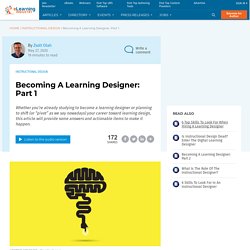
If you’re targeting K-12 and higher-ed positions, some of these thoughts may not apply. My 20+ years of experience are most relevant to the messy, real-world workplace learning. Design Thinking For Instructional Design, Part 3: Ideation. In the parts one and two of my articles on design thinking for Instructional Design have provided readers with an explanation of why I believe Instructional Designers must adopt a designer’s mindset, an overview of what design thinking is, and where you can incorporate the design thinking process “modes” into your existing Instructional Design process.
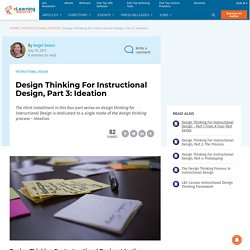
Now, it’s time to examine how – how to put the methods of design thinking to use in your organization. Design thinking modes are the mental states that a design team enters into. Design Thinking For Instructional Design, Part 2: The Process. In the first article of this series, I introduced readers to the fundamental reasons why I believe, as an industry, we need to adopt a new approach to Instructional Design.
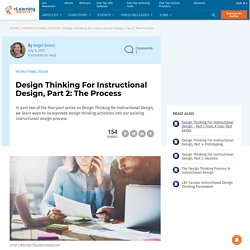
This new approach to designing and developing instructional products utilizes a method of human-centered design called design thinking. Incorporating design thinking into our existing process can help us create a better instructional product. Understanding the nuances of human behavior is difficult. Design Thinking For Instructional Design, Part 4: Prototyping. The final article in the Design Thinking for Instructional Design series (Check Part 1 here, Part 2 here, and Part 3 here) is entirely dedicated to the mode of Prototype. I decided to focus on this because, in my experience working with Instructional Designers, I see prototyping as the most underutilized and/or incorrectly implemented tools of design thinking (or agile/SAM). There are several aspects of prototyping that are fundamentally different (aka completely opposite) to the documentation, storyboarding, and draft/revision cycles typically created when following a traditional Instructional Design process.
5 Myths Of eLearning Instructional Design. Recently, I facilitated a series of meetings that quickly reminded me of a few commonly held Instructional Design beliefs. These beliefs permeate their way into our eLearning and classroom training courses under the guise of being “instructionally sound” (which, is a term, by the way, that I believe should be banned from existence – but that’s another conversation for another time). Often, Instructional Designers do these things without questioning why; as if they are requirements. Angel Green, Author at eLearning Industry. Using Design Thinking to Create L&D Programs That Meet the Needs of Workplace Learners. Good news and bad news for employee training programs The past few years have seen explosive growth in the learning and development market, which is now valued at $240 billion.
In fact, employers are now spending an average of $1,200/year on employee training and development—up 7% from last year. Josh Bersin refers to this as the “golden days of learning.” Despite significant investment on the part of employers, only 14% of employees would give their organization an “A” grade for their learning programs, and only 45% of employees say that training programs are relevant to their day-to-day jobs. Almost 75% of senior managers and leaders polled by CEB also state that they’re dissatisfied with the performance of their L&D department.
So, what’s driving the disconnect between employer investment and employee satisfaction with learning and development programs? Understanding what learners are looking for Leveraging Design Thinking to help improve learning program efficacy 1. Example 2. 3. 4. 5. Christopher Pappas, Author at eLearning Industry.